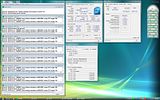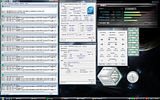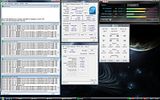The new i7 CPU are quite a good overclockers, here are some rough OC i done this weekend, havent run any benchmarks though, but just to shows that its easily reaches these clocks and stable for 30mins of Prime95 Small FFT rough stability test.

The screenshot above shows the i7 920 can easily reached 3.2Ghz with ease, what we need to do is just bump up the BCLK, to 160 with a multiplier of 20 (160*20=3200), do note that clocking of i7 are different from the old Intel Core series, thare are no longer headaches of GTL references etc, but on come a new problem with the value i7 920 series. The Core i7 is a modular design with two main areas, the “core” and the “uncore”. Inside the chip, the actual execution cores that do the heavy lifting are treated as the “core.” The other parts, such as the integrated memory controller, L3 cache, and the Quick Path Interconnect are treated as the “uncore.” Since they’re separate entities, you can overclock the execution cores without overclocking the uncore to the same degree, in theory. This should let you hit higher speeds, since you wouldn’t be running the QPI, memory controller, or L3 quite as hard. In reality, however, it doesn’t work that way. Intel’s non-Extreme Edition Core i7 CPUs offer limited control over the uncore multiplier, so a boost to the base clock boosts the uncore speeds as well. Hence, I need to bump the QPI voltage while i increasing the QPI voltage to 1.275V to maintain stability for the QPI as well as set the DRAM frequency to DDR3 1600 in BIOS. My chip did 3.2ghz no sweat with stock vcore.

The screenies above show another run in this morning, I was able to push to chip towards 3.8ghz with HT on with vcore of 1.35v, QPI voltage of 1.425v. Passed 30mins Prime95 Small FFT for rough stability test.

The overclockability of i7 are quite suprising me, after reaching 3.8GhZ, i tried to OC further, with HT off, i manage to obtain 30+ mins small FFT prime95 stable with clockspeed of 4Ghz, with Vcore of 1.4v and VQPI of 1.54375v, its quite high to run 24/7 but its up to your call, u can try running this clockspeed and voltages settings 24/7 as i saw bunches of people leaving such settings for 24/7. The Core i7 920 definately worth the buck among the top end CPU market considering you can obtain 50% or more performance through overclocking.
* Note that those OC are not yet run full stability test with Orthos Small FFT priority 10.
More benchmarks coming soon... stay tuned !!!
 And here is my own custom built with the same concept but with some low end feature without any sensors nor controllers. But its based on the same concept of the H2c, the liquid coolant ( instead of H2C's gel alike coolant) flow from pump to CPU Waterblock, cooled by the TEC module, then by the radiator and flow back to the reservoir. The hotside of the TEC module were cooled by CM Hyper 212 Air Cooler. TEC used were 90watt peltier if I not remember wrongly.
And here is my own custom built with the same concept but with some low end feature without any sensors nor controllers. But its based on the same concept of the H2c, the liquid coolant ( instead of H2C's gel alike coolant) flow from pump to CPU Waterblock, cooled by the TEC module, then by the radiator and flow back to the reservoir. The hotside of the TEC module were cooled by CM Hyper 212 Air Cooler. TEC used were 90watt peltier if I not remember wrongly. 


 From the pic, we can see that there are 4 wires in our standard 4 pins molex which used in every PSU.
From the pic, we can see that there are 4 wires in our standard 4 pins molex which used in every PSU.






 The case cooling are base on passive air cooling concept, which a case cooled by more intake fan then output fan. The blue arrows in the picture above represent cool air or cool liquid while the reds represent hot air or hot liquid.
The case cooling are base on passive air cooling concept, which a case cooled by more intake fan then output fan. The blue arrows in the picture above represent cool air or cool liquid while the reds represent hot air or hot liquid.

